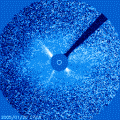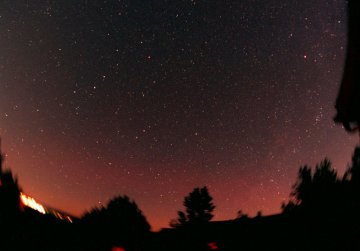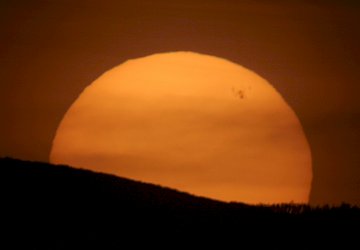 Would you like a call when auroras appear in your area? Sign up for SpaceWeather PHONE.
Would you like a call when auroras appear in your area? Sign up for SpaceWeather PHONE.
BIG BANG: Giant sunspot 720 erupted again today (Jan. 20th at 0700 GMT), unleashing a powerful X7-class solar flare. The blast hurled a coronal mass ejection (CME) into space and sparked the strongest radiation storm since October 1989.
 In this SOHO coronagraph image of today's event, the many speckles are caused by solar protons peppering the spacecraft's digital camera. These protons were accelerated to near-light speed by the X7-explosion. This is what we mean by "radiation storm."
In this SOHO coronagraph image of today's event, the many speckles are caused by solar protons peppering the spacecraft's digital camera. These protons were accelerated to near-light speed by the X7-explosion. This is what we mean by "radiation storm."
Note: ISS astronauts are in no danger from the storm because they orbit Earth inside our planet's protective magnetic field. Plus, the station itself is well shielded.
AURORA ALERT: A fast-moving coronal mass ejection (CME) hurled into space by this morning's solar blast might sweep past Earth during the next 24 hours. Sky watchers, remain alert for auroras. [gallery]
Would you believe ... auroras in Arizona? During a brief but strong geomagnetic storm on Jan. 18th, Chris Schur took this picture of a red glow over Payson, Arizona:

"This is an exellent case of a mostly photographic aurora--a deep reddish glow visible to the camera but not to the unaided eye," says Schur. "It started in the northern sky after midnight, and as the Kp index grew to 7 by early morning, the glow increased in size to more than 35 degrees over the northern horizon."
BIG SUNSPOT: Sunspot 720 is huge--about as wide as the planet Jupiter. On Wednesday, Jan. 19th, Don Brown took this picture of the sun rising over Park City, Utah. The giant 'spot is clearly visible:

This active region has unleashed four X-class solar flares, sparking bright auroras over Canada and Alaska. The latest flare, an X7-class blast on Jan. 20th, might energize a new geomagnetic storm on Jan. 21st.
NEWS FROM TITAN: Since the ESA Huygens probe landed on Titan last Friday, researchers have been working furiously to understand the data it transmitted to Earth. They'll discuss their findings at a press conference on Friday, Jan. 21st.

